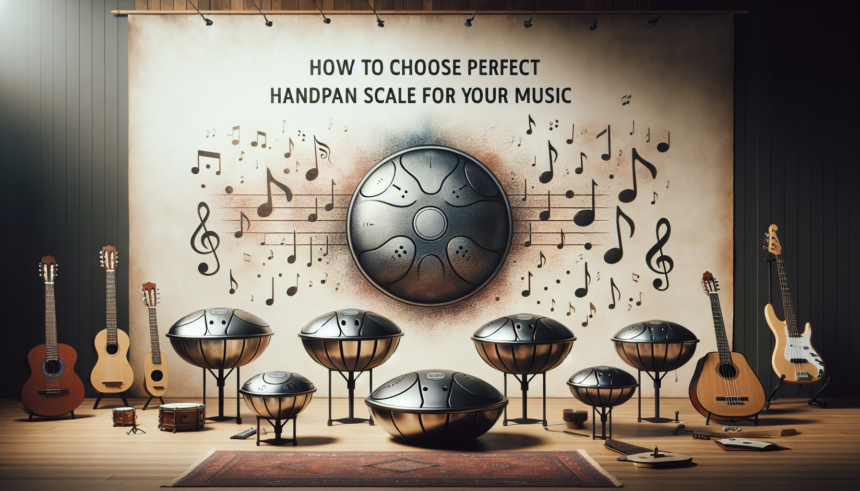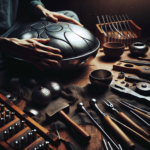<!DOCTYPE html>
<html lang="en">
<head>
<meta charset="UTF-8">
<meta name="viewport" content="width=device-width, initial-scale=1.0">
<title>How to Choose the Perfect Handpan Scale for Your Music</title>
</head>
<body>
<article>
<header>
<h1>How to Choose the Perfect Handpan Scale for Your Music</h1>
</header>
<section>
<p>The handpan, a versatile and harmonious percussion instrument, has won the hearts of musicians around the world. Originating from the Hang developed in the early 2000s, the handpan offers a unique blend of rhythm and melody. Choosing the right scale for your handpan is critical for aligning its musical potential with your artistic vision. This article aims to guide you through the key considerations involved in selecting the perfect handpan scale to enhance your musical journey.</p>
</section>
<section>
<h2>Understanding Handpan Scales</h2>
<p>Handpan scales are essential in determining the musical mood and emotional resonance of the instrument. The scale is essentially the set of notes arranged in a specific sequence that the handpan can produce. These scales can be major, minor, pentatonic, or exotic, each bringing its own tonal personality to the instrument.</p>
<p>When you start exploring handpan scales, you will come across numerous options. Here are some basic types of scales:</p>
<ul>
<li><strong>Major Scales:</strong> Known for their happy and uplifting sound.</li>
<li><strong>Minor Scales:</strong> These scales are often used to convey a sadder or more melancholy mood.</li>
<li><strong>Pentatonic Scales:</strong> Simplified scales with five notes, often used in folk and traditional music.</li>
<li><strong>Exotic Scales:</strong> Unique and less common scales that often evoke specific cultural or ethnic atmospheres.</li>
</ul>
</section>
<section>
<h2>Factors to Consider When Choosing a Handpan Scale</h2>
<p>There are several factors to consider when selecting the most suitable handpan scale. Here are the primary considerations:</p>
<h3>1. Musical Style and Genre</h3>
<p>The first thing to consider is your musical style. Different scales lend themselves better to different genres. For example:</p>
<ul>
<li><strong>Ambient and Meditation Music:</strong> Pentatonic and exotic scales can create a serene and mystical atmosphere ideal for relaxation and meditation.</li>
<li><strong>Pop and Contemporary Music:</strong> Major and minor scales can blend well with popular music styles and enhance vocal performances.</li>
<li><strong>World Music:</strong> Scales that reflect specific regional sounds can be perfect for world music projects.</li>
</ul>
<h3>2. Emotional Impact</h3>
<p>Think about the mood you want to convey. Handpan scales can express a wide range of emotions, from joy to sorrow, calm to excitement. It's essential to choose a scale that aligns with the emotional tone of your music.</p>
<h3>3. Playing Ability</h3>
<p>Your current playing ability is another critical factor. Some scales are more complex and may be challenging for beginners, whereas others are more accessible and easier to play.</p>
<h3>4. Instrument Collaboration</h3>
<p>If you plan to collaborate with other musicians, consider scales that harmonize well with other instruments. This will ensure a cohesive sound during performances and recordings.</p>
<h3>5. Personal Preference</h3>
<p>Ultimately, your personal preference plays a significant role. The handpan should inspire you and fit naturally with your musical expression. Trust your instincts and choose a scale that resonates with you.</p>
</section>
<section>
<h2>Popular Handpan Scales</h2>
<p>To help you get started, here are some popular handpan scales and their characteristics:</p>
<h3>1. D Minor (D Kurd)</h3>
<p>The D Minor scale is among the most popular and widely used scales. It offers a deep and meditative sound, ideal for creating emotional and introspective music. The notes in this scale are:</p>
<ul>
<li>D, A, Bb, C, D, E, F, A</li>
</ul>
<h3>2. C Major</h3>
<p>The C Major scale is perfect for beginners due to its straightforward, happy, and uplifting sound. It's also versatile and fits well with other instruments. The notes in this scale are:</p>
<ul>
<li>C, G, A, Bb, C, D, E, F, G</li>
</ul>
<h3>3. E Kurd</h3>
<p>Similar to the D Minor scale, the E Kurd scale has a slightly brighter sound. It's a great choice for creating atmospheric and emotional compositions. The notes in this scale are:</p>
<ul>
<li>E, B, C, D, E, F#, G, A, B</li>
</ul>
<h3>4. Ake Bono</h3>
<p>The Ake Bono scale originates from Japan and has a distinctive, exotic sound that evokes traditional Japanese music. The notes in this scale are:</p>
<ul>
<li>C, G, Ab, Bb, C, Db, Eb, G</li>
</ul>
<h3>5. Hijaz</h3>
<p>The Hijaz scale is widely used in Middle Eastern music and has a unique, expressive sound. It's great for adding an ethnic flavor to your music. The notes in this scale are:</p>
<ul>
<li>D, A, Bb, C#, D, E, F, G, A</li>
</ul>
</section>
<section>
<h2>Conclusion</h2>
<p>Choosing the perfect handpan scale for your music is a journey that involves both technical understanding and personal connection. Consider your musical style, the emotional impact you wish to achieve, your playing ability, and your plans for collaboration. Most importantly, trust your intuition and choose a scale that inspires you and fits naturally with your artistic vision. By incorporating these factors, you can find the handpan scale that perfectly harmonizes with your music and helps you create captivating and expressive compositions.</p>
</section>
<section>
<h2>Frequently Asked Questions (FAQs)</h2>
<h3>1. What is the most popular handpan scale?</h3>
<p>The D Minor or D Kurd scale is one of the most popular handpan scales due to its deep, meditative sound and versatility in creating emotional music.</h3>
<h3>2. Is the handpan suitable for beginners?</h3>
<p>Yes, the handpan is suitable for beginners. It's essential to choose a scale that's easier to play, such as the C Major scale, to facilitate learning and enhance the playing experience.</p>
<h3>3. Can I use a handpan to accompany other instruments?</h3>
<p>Absolutely! Many handpan scales harmonize well with other instruments. Choosing the right scale can allow for beautiful collaborations and cohesive performances.</p>
<h3>4. How many notes are there in a typical handpan scale?</h3>
<p>A typical handpan scale usually consists of 7 to 9 notes. However, the arrangement and specific notes can vary depending on the scale and the handpan maker.</p>
<h3>5. Do handpan scales vary between makers?</h3>
<p>Yes, handpan scales can vary between different makers. Some handpan makers specialize in specific scales, while others offer a wide range of scale options. It's essential to explore different makers and their offerings to find the perfect handpan for you.</p>
</section>
</article>
</body>
</html>How to Choose the Perfect Handpan Scale for Your Music

Leave a comment




